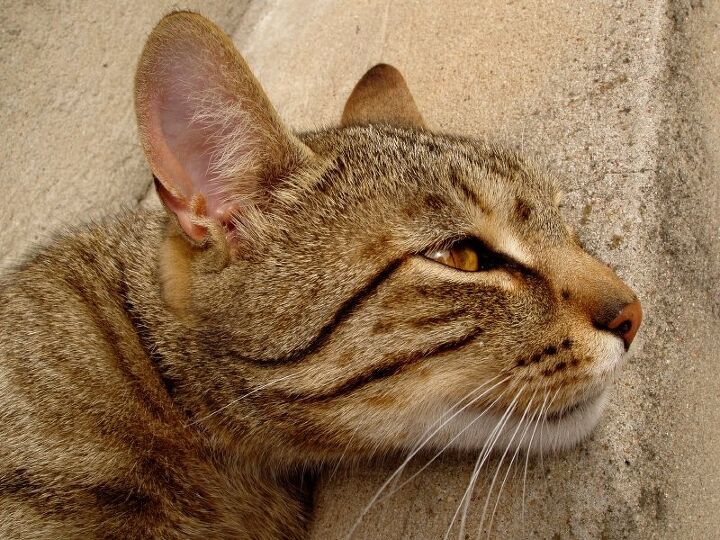Ear Mites In Cats Lead To Serious Scratching

A common problem that affects many felines, ear mites in cats are an annoying and painful issue for your pet and a frustrating one for you, too. Also known as Otodectes cynotis, these mites are tiny insects that live in the ear canal and eat its fill by piercing the cat’s skin. While they can be barely noticed by the naked eye, it won’t be too difficult to realize that your cat has them due to the intense irritation they cause.
Unfortunately, ear mites are easy to catch and pass along. Once your cat has ear mites, you’ll notice lots and lots of intense itching, scratching and head shaking. And it’s not your regular itch to be scratched- this will present itself like extreme scratching. The ears are often red and inflamed and the interior of the ear holds even more clues that could help determine the presence of ear mites. Look into your cats ears and you’ll dry, crumbly, dark brown, waxy discharge that looks like coffee grounds and smells pretty gross. From a simple irritation to an intense allergic reaction, ear mites in cats manifest itself in many different ways. If your cat keeps scratching at her ears, this may cause raw areas, scabs and loss of hair. If it continues, your cat may catch a chronic bacterial infection.
Of course, even if all the signs are there, those pesky ear mites are hard to see with your naked eye (not to say impossible), so you’ll need to take your cat to the vet for actual diagnosis confirmation and treatment. There are various causes that could cause ear issues that manifest with discharge and intense itching and only an expert can tell you with utmost certainty what is the reason for your cat’s newly found ear problems. The vet will either use an otoscope to take a peek in your cat’s ears and identify the critters, or take a swab of the discharge and analyze the sample under a microscope. If the infestation is too severe making the examination painful or your pet refuses to cooperate, they can be sedated for the duration of the examination for their ease and comfort.
If, in the end, it’s ear mites that are tormenting your pet, it’s particularly bad news if you have multiple pets in the household – ear mites, much like bad news, travel fast, and can be picked up by all the animals in a short period of time. On the plus side, humans can’t catch ear mites (woo hoo!). This “just” means you’ll have your hands full with treatments for all your four-legged companions.
Treatment of Ear Mites in Cats
It’s crucial not to treat ear mites in cats based on your hunch or though that it’s in fact these insects bothering your pet. Don’t start treatment of ear mites in cats until the vet has made a confirmation, as not only it might not be ear mites in the first place, but the severity of the infestations vary and require different approaches to what’s, essentially, the same issue. Because ear mites dive deep into a cat’s ear canal, it can be difficult to get at them and may lead to secondary infections, so you might be treating the ear mites properly but failing to notice that your cat has also developed a bacterial or a fungal infection as a result of the irritation, and that could do even more harm to your pet.
Before you start using the medication that kills ear mites in cats, you’ll have to clean out your kitty’s ears (dirty ear canals hold wax and cellular debris houses mites and makes it hard for the medications to do its work). Be sure to follow your vet’s instructions on proper dosage and frequency, and complete the recommended course of treatment – those little buggers will pop back up if you stop the treatment too soon! It’s very important to be persistent and vigilant to make sure that the treatment is truly effective.
Ear mites might be a pain, but they are clever. To get away from the medication, the ear mites may escape from the ear and take refuge on other parts of your cat. Using a topical insecticide preparation, treat your whole cat with the medication… including the tail. This will kill the little buggers on the spot if they try and run anywhere on your pet’s body. Another thing you can do to make things easier for your cat while the treatment is ongoing is to clip their nails to prevent deep wounds and pain from constant scratching.
Cleaning Your Cat’s Ears
They say that “an ounce of prevention is worth a pound of cure” and it really is true for ear mites. Of course, you don’t need to make ear cleaning a regular part of your cat’s regular grooming routine, as some ear wax is important for her well-being. Everything has its purpose in the body, even ear wax! Ears should only be cleaned when there is a lot of wax, dirt, or debris build-up. To clean all this gunk away, use a damp cotton ball or a cotton-tipped swab. You shouldn’t put any cleaning solution directly in your cat’s ear, unless you are sure that her eardrum is intact. Similarly, you should be very gentle with the cotton ball or swab, and don’t try inserting the tip too deep in the ear.
There’s also the option of using ear-cleaning solutions instead. To make a DIY ear solution, just use a few drops of warm mineral oil, olive oil, and a diluted vinegar solution (three drops white vinegar in 1 ounce of water). You can also buy an ear-cleaning solution from your veterinarian. After applying the solution, massage it into the external ear canal and massage the base of the ear to loosen dirt, wax, and debris. Once you’ve given your cat’s ear a cleansing massage, wipe out the ear with a cotton ball.
If you have any tips on how to remove ear mites in cats, please leave your suggestions in the comments section.

Amy Tokic, Editor of PetGuide.com, is a passionate animal lover and proud pet parent of Oscar, a Shih Tzu/Chihuahua cross, and Zed, a Japanese Chin. Her love of animals began in kindergarten, when she brought her stuffed dog Snoopy into class with her every day. Now, she writes about her adventures in pet ownership and tirelessly researches products, news and health related issues she can share with other animal enthusiasts. In her free time, Amy loves perusing used book and record stores, obsessing over the latest pet products available and chasing squirrels with wild abandon (a habit attributed to spending too much time with her pooches).
More by Amy Tokic























